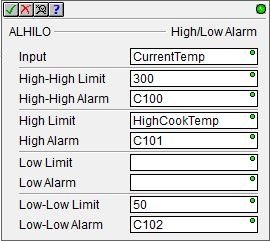Topic: DMD0002
ALHILO - High/Low Alarm
The High/Low Alarm instruction (ALHILO) monitors the Input and sets the appropriate alarms based on the alarm limit values.
When entering the alarm limit values, ensure that the High-High Limit value is greater than the High Limit value, which must be greater than the Low Limit value, which must be greater than the Low-Low Limit value.
When designating the alarm bits, ensure that all of the alarm bit references are unique.
The alarm states are inclusive. Both the High-High Limit and High Limit alarms will be ON when the input value is greater than or equal to the High-High Limit. Both the Low Limit and the Low-Low Limit alarms will be ON if the input value is less than or equal to the Low-Low Limit.

Parameters:
Note: Use the F9 key (Element Browser) or Down-Arrow key (Auto-Complete) at any time to see a complete list of the memory locations that are valid in the current field of the instruction.
Input
HH Limit, H Limit, L Limit and LL Limit - identify the alarm limit values. These values can be any constant value or any readable numeric location.
HH Alarm, H Alarm, L Alarm and LL Alarm - identify the alarm bits. These values can be any writable bit locations.
Note: Each Alarm/Limit pair is optional. Leave both fields empty to indicate that Limit is not being used, otherwise enter values for both fields to indicate that Limit is used.
Status Display:
When the ladder status is ON, in addition to the standard status values
being displayed, the High/Low Alarm instruction also displays two "mini-trends"
that show the instruction's values graphically.
The top graph shows the input value and the four Alarm limits.
The bottom graph shows the four Alarm output BITs
The mini-trend display can be disabled in the View-> Options menu, select the Ladder tab, then uncheck the Show Trend Status selection.

See Also:
ALHILO - High/Low Alarm
Related Topics:
Rung Example:
